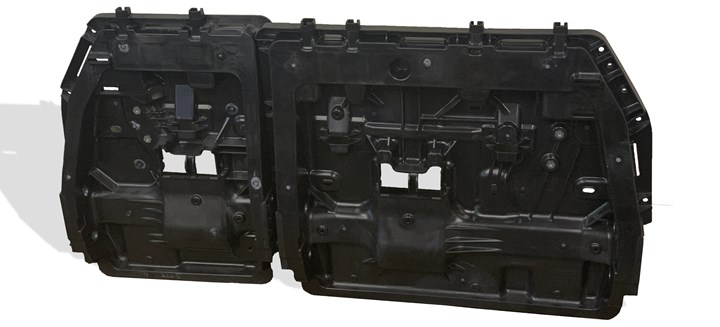BASF, Toyota collaborate for 2021 Sienna lightweighting
The 2021 Toyota Sienna features third row free-standing seatbacks and a 30% weight reduction with BASF’s 35% glass-reinforced polyamide PA6 grade Ultramid.

2021 Toyota Sienna third-row seatback. Source | BASF
BASF (Wyandotte, Mich., U.S.) and Toyota Motor North America Research & Development (Ann Arbor, Mich., U.S.) announced on August 5 the company’s lightweighting success with the new 2021 Toyota Sienna. The vehicle, scheduled to launch later this year, recently won the prestigious Altair Enlighten Award for achievements in vehicle weight savings for reduced mass of the third-row seat.
It is noted that in the previous model, the third-row seat was comprised of 15 different steel components, making it very heavy. Toyota notes that, because it wanted the vehicle’s third seat to be lighter and cost-competitive, while exceeding all performance criteria, the company turned to BASF to help them achieve this lightweighting goal.
“Lightweighting doesn’t always have to be more expensive,” comments Todd Muck, from the Toyota technical strategic planning office at the Toyota R&D Center in Saline, Mich., U.S. “We were able to meet our cost objective and saved 15% compared to the prior generation. The seat is 30% lighter compared to the previous model. We had some great partnerships that helped us achieve these targets, one of which was BASF.”
Traditionally, resin components for seating have reportedly had metal reinforcement, which can add more cost to the process. Toyota also wanted an injection molding part that was a shoot-and-ship part, meaning it was made in one piece without complex and costly post-processing. With BASF’s 35% glass-reinforced and impact-modified polyamide PA6 grade Ultramid B3ZG7 CR, and its and its proprietary computer aided engineering (CAE) tool Ultrasim which allowed for accurate CAE simulations during the multiple phases of development efforts, these goals could be achieved.
“The third seat design is what I would classify as an enabling technology,” says Matt Parkinson, manager of applications development engineering and composite technologies, for BASF Performance Materials. “It is the first of its kind in the way it is designed without inserts as a fully injected seat back. One of the challenges was to ensure a high elongation and impact qualities for the crash requirements. At the same time, we focused on strength and stiffness because the seat also serves as a load floor.”
Related Content
-
Automotive chassis components lighten up with composites
Composite and hybrid components reduce mass, increase functionality on electric and conventional passenger vehicles.
-
CirculinQ: Glass fiber, recycled plastic turn paving into climate solutions
Durable, modular paving system from recycled composite filters, collects, infiltrates stormwater to reduce flooding and recharge local aquifers.
-
JEC World 2022, Part 1: Highlights in sustainable, digital, industrialized composites
JEC World 2022 offered numerous new developments in composites materials, processes and applications, according to CW senior editor, Ginger Gardiner, most targeting improved sustainability for wider applications.










.jpg;maxWidth=300;quality=90)





